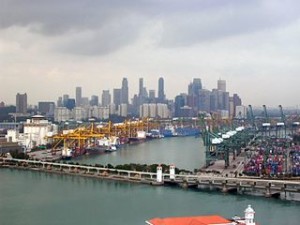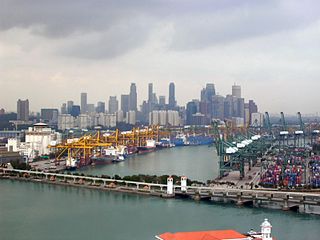 Singapore has narrowed its forecast for gross domestic product (GDP) growth in 2015 to 2% to 2.5% from 2% to 4% as its manufacturing and transport sectors feel the effect of the subdued growth arc of the global economy.
Singapore has narrowed its forecast for gross domestic product (GDP) growth in 2015 to 2% to 2.5% from 2% to 4% as its manufacturing and transport sectors feel the effect of the subdued growth arc of the global economy.
In an official release, the Ministry of Trade and Industry (MTI) said the city-state’s economy expanded at a slower pace in the second quarter of 2015, growing by 1.8% on a year-on-year basis and moderating from the 2.8% growth in the preceding quarter.
The slowdown can largely be attributed to weaker performance in the manufacturing and transportation & storage sectors, according to Ow Foong Pheng, Permanent Secretary at MTI.
On a quarter-on-quarter seasonally adjusted annualized basis, the economy contracted by 4%, a reversal from the 4.1% growth in the preceding quarter.
In the first half of 2015, the economy grew by 2.3% on a year-on-year basis, slower than the 2.9% achieved in 2014. The slowdown in growth can be attributed to sluggish global economic conditions in the first half of 2015, as well as sector-specific factors.
For the rest of 2015, global growth is expected to pick up gradually, although the pace is likely to be uneven across economies. In particular, the advanced economies are expected to see a gradual pick-up, but the growth outlook of regional economies has generally softened.
Looking at the prospects of individual regions for the rest of the year, MTI said the U.S. economy, following its recovery in the second quarter from harsh weather conditions at the start of the year, is projected to grow at a modest pace, supported by private domestic demand on the back of continued improvements in the labor and housing markets.
The Eurozone economy is expected to improve in the second half of 2015, with growth supported by the quantitative easing measures implemented by the European Central Bank since March. Further depreciation of the euro as a result of the quantitative easing will also help to boost the Eurozone’s export competitiveness. However, growth in the bloc will likely remain modest due to sluggish labor market conditions.
In Asia, China’s growth is projected to ease, weighed down by the ongoing property market correction and excess capacity in the heavy industries. Nonetheless, the stimulus measures implemented by the Chinese government are expected to contain downward pressures on the economy.
The slowdown in the Chinese economy could in turn dampen the exports of key Association of Southeast Asian Nations (ASEAN) economies. Weaker exports, coupled with softening domestic demand, could weigh on the growth of key ASEAN economies in the second half of the year.
MTI identified several key downside risks to the outlook, including the risks from China’s recent sharp correction in the stock market and from a sharper-than-expected correction in the real estate market.
In the Eurozone, there is the risk of continuing political uncertainty and another flare-up in the Greek crisis, while risks linked to the United States include the appreciation of the U.S. dollar and anticipated normalization of U.S. interest rates that could lead to capital outflows for the region and added pressures on their currencies and asset markets.
“Taking these factors into account, the 2015 growth forecast for the Singapore economy is narrowed to
2.0 to 2.5 per cent, from 2.0 to 4.0 per cent,” said Ow.
Expected growth drivers for Singapore in the second half of 2015 are the externally oriented sectors such as finance & insurance and wholesale trade, in line with the expected gradual pick-up in the global economy.
Sectoral scorecard
Breaking down Singapore’s growth in the second quarter on a sectoral basis, MTI said the manufacturing sector contracted by 4.9% year-on-year, extending the 2.4% decline in the previous quarter. The sector was primarily weighed down by declines in the output of the biomedical manufacturing and transport engineering clusters.
The construction sector expanded at a faster pace of 2.5% year-on-year compared to the 1.1% in the previous quarter. Growth was supported by a pick-up in public sector construction works.
The wholesale & retail trade sector grew by 5% year-on-year, slightly slower than the 5.3% expansion in the previous quarter. Growth was driven by both the wholesale trade and retail trade segments, with the latter being supported in turn by robust motor vehicle sales.
The transportation & storage sector contracted by 0.9% year-on-year, in contrast to the 1.4% growth in the previous quarter. The pullback was largely due to the water transport segment, which contracted as sea cargo handled declined.
The accommodation & food services sector contracted at a faster pace of 0.6% year-on-year compared to the 0.1% decline in the previous quarter. The slowdown in the sector was largely due to sluggish performance in the food & beverage segment.
The information & communications sector grew by 4.5% year-on-year, moderating from the 4.9% growth in the previous quarter. Growth was mainly driven by the IT & information services segment.
The finance & insurance sector posted growth of 7.1% year-on-year, extending the 7.8% growth in the previous quarter. Growth was largely underpinned by the fund management segment.
The business services sector expanded by 2% year-on-year, slower than the 3.2% growth in the previous quarter. Growth was supported by the rental & leasing and other administrative & support services segments.
The “other services industries” grew by 1.6% year-on-year, similar to the 1.8% growth in the previous quarter. Growth of the sector was supported by the public administration & defence and education, health & social services segments.
Photo: See Hoy Kim





